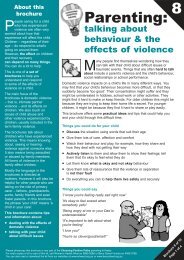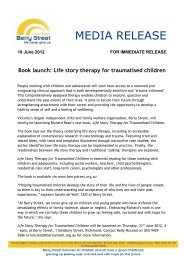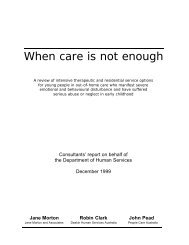Therapeutic foster care - Berry Street Childhood Institute
Therapeutic foster care - Berry Street Childhood Institute
Therapeutic foster care - Berry Street Childhood Institute
Create successful ePaper yourself
Turn your PDF publications into a flip-book with our unique Google optimized e-Paper software.
“One of the major service gaps that led to the formation of<br />
the Stargate program was that children and young people<br />
entering <strong>care</strong> have not been able to access a mental health<br />
service until a stable placement had been established. There<br />
are sound therapeutic principles behind this requirement,<br />
in that theoretically one must have stability in one's life<br />
before issues of an emotional and traumatic nature can be<br />
effectively addressed. In reality many of the children and<br />
young people entering <strong>care</strong> do not achieve a stable<br />
placement for some time, often years. The Stargate program<br />
works from the philosophy that broader system change to<br />
achieve immediate stability is crucial; however, working<br />
within the system to address the aftermath of trauma and<br />
disruption is possible, and in fact intervening at the time of<br />
disruption and change can enhance outcomes at the crucial<br />
systemic case planning stage, and working with the family<br />
at a time of crisis gives opportunities for change that might<br />
not otherwise be present further down the track” (Stargate<br />
report, 2002, p. 46).<br />
Other systemic difficulties such as the child's<br />
experience of transience (multiple placement change)<br />
and uncertainty (length of placements) further<br />
compound the child's reduced social, emotional and<br />
psychological wellbeing, and their access to mental<br />
health services (Clare, 2001). Studies have found that,<br />
“Children in <strong>care</strong> do not receive appropriate quality of<br />
health <strong>care</strong> because of frequent moves and unclear<br />
arrangements” (Arcelus et al., 1999, p. 235). Such<br />
systemic factors need to be acknowledged and their<br />
impact considered when developing comprehensive<br />
service provision models for children in <strong>care</strong>. These<br />
may include greater flexibility and continuity across<br />
service sector borders or priority transition planning<br />
and commitments between services for children in<br />
out of home <strong>care</strong>.<br />
One study has compared the access of mental health<br />
and other services used by youth in therapeutic <strong>foster</strong><br />
<strong>care</strong> (TFC) to that of youth in group homes (Breland-<br />
Noble et al., 2005). The findings suggest that youth in<br />
TFC were more likely to receive community-based,<br />
individualised services such as: in-home counselling,<br />
respite, seeing a medical doctor, participating in after<br />
school programs, adult mentors or therapeutic<br />
recreational services. In contrast to this, youth in<br />
group homes were more likely (than TFC youth) to<br />
receive restrictive services such as attending a<br />
detention facility, have a probation officer and to<br />
receive hospital-based mental health interventions<br />
such as to work with a psychologist, psychiatrist or<br />
therapist, visit an emergency room and attend a<br />
special school (Breland-Noble et al., 2005, p. 175).<br />
Such findings indicate that children in TFC receive<br />
and have access to different kinds of therapeutic<br />
services, with a particular lack of specialist<br />
psychological and psychiatric treatment. By<br />
identifying youth's access or lack of access to mental<br />
health services this study provides a useful base for<br />
further research into the real needs of children and<br />
youth <strong>care</strong>, and highlights the advantages and<br />
disadvantages experienced by youth in different <strong>care</strong><br />
settings. In addition to this, further research is<br />
required to explore the barriers and access to<br />
therapeutic services for <strong>care</strong>rs themselves (with or)<br />
without the children in their <strong>care</strong>) in order to gain the<br />
support, consultation and training they require as<br />
'primary healers'.<br />
Evidence-based and recommended treatment<br />
interventions<br />
A number of authors have explored the prevalence of<br />
social, emotional and psychological difficulties for<br />
children in out of home <strong>care</strong> (Clare, 2001; Arcelus et<br />
al., 1999; Schneiderman et al., 1998; Leslie et al., 2005a;<br />
Leslie et al., 2005b; McMillen et al., 2005; Breland-<br />
Noble et al., 2005). Despite this understanding of the<br />
psychological difficulties children in <strong>care</strong> present<br />
with, a challenge in the area of child psychiatry has<br />
been the lack of development and consensus of<br />
effective treatment for children with traumaattachment<br />
difficulties (Rushton & Minnis, 2002).<br />
Whilst there are some promising treatment<br />
interventions that appear effective for this group, the<br />
evidence for these interventions is limited. Evidencebased<br />
treatment interventions for traumatised<br />
children in <strong>care</strong> include: Dyadic Developmental<br />
Psychotherapy (Hughes, 1997, Becker-Weidman,<br />
2006), Theraplay (Jernberg and Booth, 2001),<br />
Neurosequential model (Perry, 2006), Attachment and<br />
Biobehavioral catch-up intervention model (Dozier,<br />
2005) and Trauma focused cognitive behavioural<br />
therapy (Cohen, 2004). There is also evidence to<br />
suggest promise in other interventions such as Parent-<br />
Child Interaction Therapy, for biological families, and<br />
Dialectic Behavioural Therapy for older adolescents.<br />
Treatment models for traumatised children in <strong>care</strong><br />
which emphasise a relational approach are noted as<br />
being most effective. “The only interventions with<br />
demonstrated effectiveness in reducing the emotional and<br />
behavioural problems of looked-after children are those<br />
delivered either in close liaison with <strong>foster</strong> <strong>care</strong>rs, or<br />
directly through <strong>foster</strong> <strong>care</strong>rs” (Rushton & Minnis, 2002,<br />
p. 369). Despite this finding, a difficulty in treating<br />
children in out of home <strong>care</strong> is sometimes the absence<br />
of a consistent and committed <strong>care</strong>r. This absence of a<br />
<strong>care</strong>giver to participate in dyadic therapy with the<br />
child may be attributed to the transience of <strong>foster</strong> <strong>care</strong><br />
with some children experiencing multiple placements<br />
throughout their time in <strong>care</strong> with no consistent <strong>care</strong>r.<br />
Referral and assessment process<br />
International research supports the benefits of providing<br />
comprehensive assessments for all children who enter<br />
out of home <strong>care</strong> (Leslie et al., 2005b). In Victoria, the<br />
provision of physical, developmental and mental health<br />
assessments of children in <strong>care</strong> varies. Practice principles<br />
such as the 'Looking after Children' (LAC) tool provide<br />
a systematic screening for children in <strong>care</strong>. Such<br />
practices go some way to ensure that children's health<br />
<strong>care</strong> needs are identified and the provision for treatment<br />
intervention plans to be developed.<br />
Whilst such screening tools are useful, the process of<br />
referral and assessment for children in out of home<br />
8 <strong>Therapeutic</strong> Foster Care
















